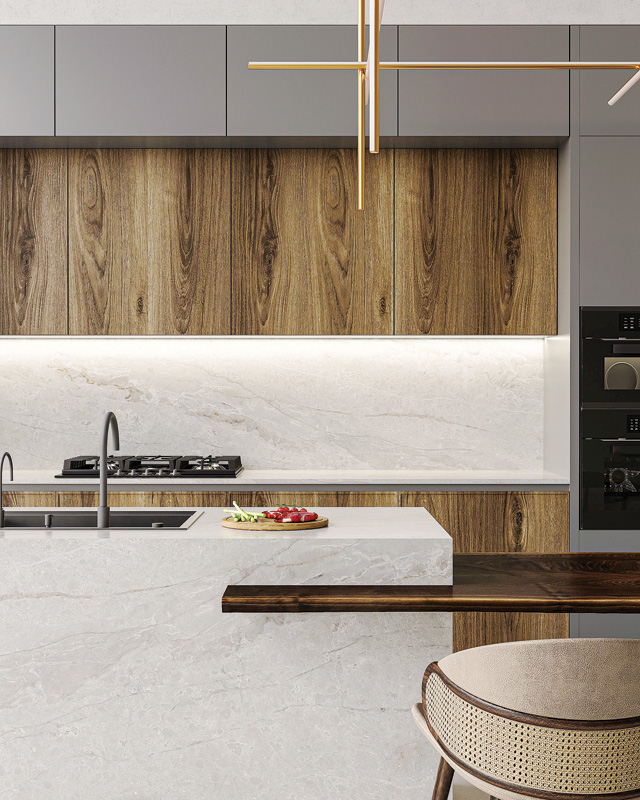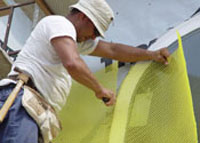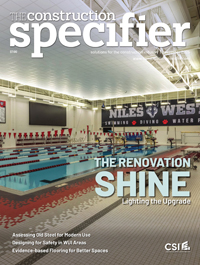Porcelain and quartz: A rock-solid alternative to natural stone
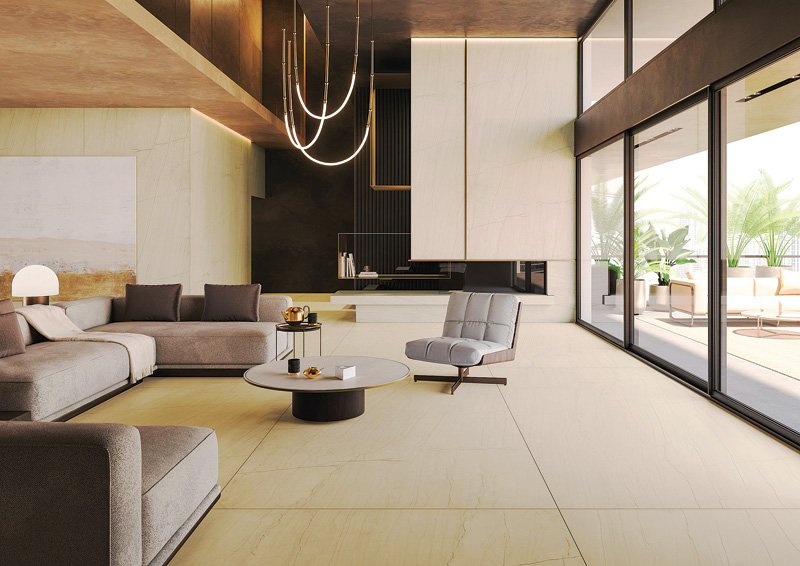
As contemporary architecture continues to push design boundaries, innovations in masonry materials such as porcelain and engineered quartz are reshaping the creative possibilities. Thanks to manufacturing innovations and material advances that produce more colors, finishes, and larger slab sizes, architects and designers now have greater creative freedom in where and how they incorporate these masonry elements.
Beneath the surface
Porcelain and engineered quartz each possess characteristics that make them ideally suited for virtually any commercial application that requires a durable, attractive, and easy-to-maintain surface.
Porcelain is made from a blend of natural clay and minerals fired at extremely high temperatures. This intense firing process creates a dense, non-absorbent material resistant to moisture, stains, and scratches. Compared to natural stone, which is porous and requires sealing and long-term care, porcelain is considered non-porous and does not require these extra steps. Since porcelain can be manufactured to look like natural stone, it is a popular alternative, especially for exterior projects exposed to natural light and areas subject to high heat.
Engineered quartz is a manufactured material that contains natural quartz. Natural quartz is a hard, crystalline mineral made of silicon dioxide. Manufacturers combine 90 to 95 percent crushed natural quartz with five to 10 percent resins, polymers, and pigments to create highly durable slabs in a variety of colors and patterns. The resin content of engineered quartz provides slight flexibility that reduces the risk of cracking, while the quartz ensures a hard-wearing, resilient surface. Like porcelain, engineered quartz can mimic the look of natural stone, but it is less heat resistant than porcelain.
Seamless looks from floor to ceiling
When selecting masonry materials for a project, architects and designers weigh several factors.
First is aesthetics, and porcelain and engineered quartz are highly versatile when it comes to design. Not only do they offer their innate visual qualities, but they can also mimic the appearance of other masonry materials. Advances in printing technology, for instance, can now render high-definition images and textures, enabling remarkable realism. Likewise, extra-large slabs can replicate the look of marble or other natural stone with uninterrupted veining patterns. Designers can further customize their visions, choosing from dozens of colors plus a variety of finishes from matte and glossy to textured, polished, honed, or brushed surfaces.
A second consideration for selection is where the material will be used. Popular applications of porcelain and/or engineered quartz slabs include:
- High-traffic flooring—Found in shopping malls, airports, office lobbies, and hotels, porcelain is a great option that delivers attractive options with durability and easy maintenance.
- Wall cladding and feature walls—In corporate buildings, retail stores, and luxury residences, both materials are used to create sleek, seamless facades and interior decorative elements.
- Countertops and work surfaces—Porcelain and engineered quartz are common in restaurants, hotels, and commercial kitchens where hygiene, stain resistance, and long-term durability are key considerations.
- Reception desks and conference tables—Frequently incorporated into office and hospitality settings, these materials offer aesthetic appeal and long-term wear resistance.
- Vanities and shower walls—Large slabs are ubiquitous in commercial restrooms and hotel bathrooms due to fewer seams, moisture resistance, and easy upkeep.
- Exterior facades—Porcelain is the choice for office buildings, hotels, and mixed-use developments where weather resistance and UV stability are important.
- Outdoor dining and entertainment spaces—Used in patios, countertops, and bar areas, porcelain slabs stand up to the elements with high heat tolerance and UV resistance.
- Hospitality and retail displays—Applied in luxury retail counters, shelving, and boutique storefronts, both materials are visually versatile and customizable.
One reason porcelain and engineered quartz have gained popularity in these applications is that manufacturers now produce slabs in larger sizes. Engineered quartz, for example, is available in jumbo slabs that measure around 1,651 x 3,302 mm (65 x 130 in.) and super jumbo slabs of about 1,981 x 3,505 mm (78 x 138 in.). These larger slabs have earned favor because they allow designers to create monolithic surfaces with notably fewer visible seams or no seams. Larger slabs require less installation labor and are often more readily available than natural stone alternatives.
Other qualities that make porcelain and engineered quartz attractive for commercial applications include:

Resistance to chipping and cracking
Some natural stone materials, such as marble and travertine, are softer or naturally porous, making them more susceptible to chipping and cracking if not carefully handled or properly treated. Porcelain and engineered quartz are highly durable and can be more forgiving during fabrication, installation, and daily use. When tested to EN ISO 10545-5, porcelain demonstrates an average impact resistance value greater than 0.85. Quartz is tested to ASTM C1870-18, with typical results showing an indentation depth of ≤ 6.35 mm (0.25 in.) from a 914-mm (36-in.) ball drop and ≤ 6.8 mm (0.27 in.) from a 1,219-mm (48-in.) ball drop.
Stain and scratch resistance
Both porcelain and engineered quartz excel in stain and scratch resistance, making them ideal for high-use surfaces. Porcelain’s non-porous nature ensures that spills, even from coffee or wine, do not penetrate the surface, making it perfect for countertops, work surfaces, vanities, and outdoor dining areas. When tested to EN ISO 10545-6, porcelain demonstrates an average abrasion volume loss of less than 145 mm³ (0.00885 in³)—well below the 175 mm³ (0.01067 in³) threshold set by EN 14411 Group G. Its stain resistance also earns a rating of Class 5 when tested to EN ISO 10545-14, indicating excellent protection against common staining agents.
Engineered quartz, with its dense and durable composition, also resists everyday wear and tear, maintaining its smooth and polished appearance even in busy spaces. It achieves a Mohs hardness rating of ≥6 when tested to EN 101:1991, demonstrating strong scratch resistance. Regarding stain performance, quartz earns a Class A rating under ASTM C1378-04:2014 (polished finish), indicating high resistance to household stains.
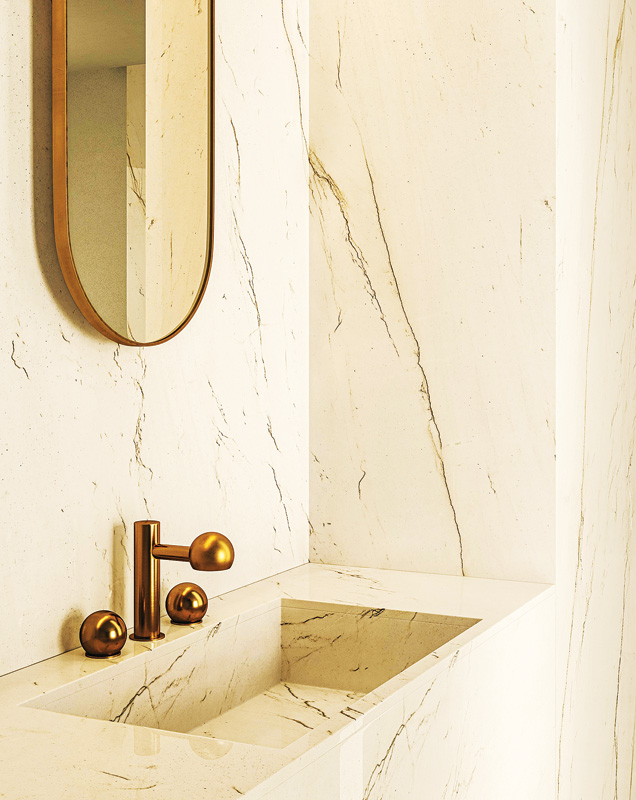
Heat resistance
Porcelain is highly heat-resistant, withstanding temperatures up to 650 C (1,200 F) in real-world applications. This makes it ideal for fireplace surrounds, outdoor kitchens, and countertops near high-heat appliances. It passed EN ISO 10545-9 thermal shock testing with no visible damage, confirming its stability under rapid and extreme temperature changes.
Engineered quartz, while offering moderate heat resistance, is not heatproof. Manufacturers generally advise quartz surfaces can withstand up to 150 C (300 F) for short durations. Exposure to temperatures exceeding this range, especially from hot pots or pans placed directly on the surface, can lead to discoloration, cracking, or other forms of damage due to the resin components in quartz. To preserve the integrity and appearance of quartz countertops, it is recommended to always use trivets or heat pads under hot cookware.
Long-term durability and maintenance
Porcelain and engineered quartz slabs are ultra-dense and only need basic cleaning to maintain their appearance. Compared to a natural stone (e.g. granite) that requires periodic sealing to prevent staining and etching, porcelain and engineered quartz offer hassle-free solutions with minimal care.
UV sensitivity
For exterior projects exposed to UV light, porcelain is a clear winner, as it remains color-stable even in outdoor settings. Natural stone can also perform well outdoors; however, some varieties use resin to smooth rough surfaces, and that resin may yellow over time with prolonged sun exposure. Engineered quartz, while durable indoors, is not suitable for exterior use. Its resin binders can begin to yellow in as little as six to 12 months when exposed to direct sunlight, with discoloration becoming more pronounced over time, especially in lighter colors.
Cost
Porcelain and engineered quartz offer a variety of price points, providing options for different budgets. Natural stone also varies in cost, with some varieties being relatively budget-friendly and others, particularly exotic marbles and quartzites, commanding premium prices.
The balance of beauty, performance, and customization makes porcelain and engineered quartz practical solutions and essential design elements in modern spaces.
Tips for choosing a manufacturer and supplier
Selecting a quality porcelain or engineered quartz manufacturer and a dependable supplier is crucial for ensuring material consistency and reliable availability. Questions to ask and qualities to look for in a manufacturer and supplier should include:

Lead times and available stock
A supplier with a large selection and deep inventory ensures material availability, minimizes project delays, and provides specifiers with greater flexibility in design choices.
Consistency in material quality and color batches
Verify that the manufacturer maintains uniformity in color and texture across slabs. This is especially important for large-scale commercial projects requiring multiple pieces. A supplier with deep inventory and single-source procurement by color can expedite this verification by providing side-by-side comparisons of multiple slabs in the chosen color.
Material warranty
Choose a manufacturer that offers a comprehensive warranty covering material defects, durability, and performance over time. A strong warranty protects firms and clients from unexpected replacement costs and is considered a trustworthy sign of manufacturer integrity.
Certifications for durability, safety, and sustainability
When selecting surface materials, look for third-party certifications that verify the product meets industry standards for durability, fire resistance, safety, and environmental sustainability. Important certifications include:
- ASTM C373 for water absorption and ASTM C648 for breaking strength. Both are key indicators of durability.
- For fire resistance, materials are typically classified according to ASTM E84, Standard Test Method for Surface Burning Characteristics of Building Materials, which assigns a flame spread and smoke development rating. Class A is the most fire-resistant.
- NSF certification (NSF/ANSI 51 or 61) confirms the material is safe for use in commercial food preparation areas.
- GREENGUARD certification verifies the product meets strict chemical emissions limits for healthier indoor air quality.
- Declare Label participation lists ingredients and ensures the product does not contain any materials found on the Living Building Challenge Red List.
These certifications help specifiers, designers, and builders make informed decisions about materials that are high-performing, safe, and environmentally responsible.
Customer service and technical support
Seek a supplier with a reputation for offering a seamless experience from sampling to delivery. Technical documentation, fabrication guidelines, and specification and installation assistance should also be part of the relationship to ensure proper material handling and application of the product.
Working with a reliable manufacturer and supplier helps ensure the material consistency and long-term performance of porcelain and engineered quartz slabs. As the industry evolves, new manufacturing techniques and innovations will only enhance these materials, making them even more valuable in modern masonry and architectural design.
Environmental stressors and material performance
Masonry materials are subjected to various environmental stressors that can impact their appearance and performance. See Figure 1 for a look at how porcelain, engineered quartz, and natural stone such as marble perform under these conditions. Cost is removed from the table because it can vary so widely with natural stone. It is tough to categorize marble as always more due to market-specific factors.
figure 1
| Factor | Porcelain | Engineered quartz | Marble (Natural stone) | Explanation |
| Chipping and cracking | High risk | Low risk | Moderate risk | Quartz has resin content, reducing the chances of chipping and cracking. |
| Stain and scratch resistance | Excellent | Excellent | Requires sealing | Porcelain and quartz are non-porous and naturally resistant to stains and scratches. |
| Heat resistance | Excellent | Good | Excellent | Porcelain and marble handle high heat well; quartz can be heat-sensitive. |
| Durability and maintenance | Low maintenance | Low maintenance | Requires sealing | Porcelain and quartz need little upkeep; marble requires regular sealing. |
| UV sensitivity | UV resistant | May yellow over time | UV resistant | Porcelain and marble resist fading; quartz may yellow with UV exposure. |
| Extra-large slab availability | Yes | Yes | Limited availability | Porcelain and quartz come in large slabs; marble sizes depend on natural stone block availability. |
| Material availability | Widely available | Widely available | Varies by quarry | Porcelain and quartz are mass-produced; marble depends on quarry output. |
Author
Matt DiNorcia is a strategic sales manager at UMI | The Source, focusing on the southeast region. He plays an integral role in shaping sales strategy and developing internal systems to optimize customer relationships and streamline operational efficiency, ensuring seamless service and growth for UMIStone.com client base.
Key Takeaways
Porcelain and engineered quartz offer durable, low-maintenance, and versatile surfaces ideal for commercial applications like flooring, wall cladding, and countertops. Advances in large slabs and finishes provide designers greater creative freedom. Both materials resist stains, scratches, and heat, with porcelain especially suited for outdoor applications. Compared to natural stone, these materials deliver consistent quality and fewer seams. Choosing reliable suppliers ensures project success and long-term performance.

